Nothing beats the basic yet strong red chilli pepper for giving a scorching bite and brilliant colour to our favourite recipes. This versatile spice has been essential in numerous dishes throughout the world for its hot flavour and eye-catching red colour. Red chilli peppers, however, provide a nutritional punch that may surprise you.
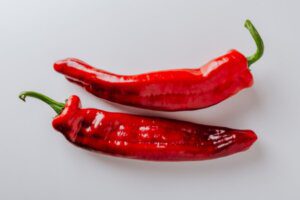
Red chilli pepper nutrition
Red chilli pepper is high in key nutrients and has several health advantages. The nutritional content of red chilli pepper per 100 grams is as follows:
Calories: Around 40-50 calories
Carbohydrates: 8.81 g
Protein: 1.87 g
Total Fat: 0.44 g
Fibre: Approximately 5 grams
Vitamin C: 143.7 mg
Vitamin A: 48 mcg
Potassium: 322 mg
Calcium: 14 mg
Iron: 1.03 mg
Cholesterol: 0 mg
Sodium: 9 mg
Because of this amazing nutritional profile, including red chilli pepper in your meals may not just offer a hot taste but can also contribute to a well-balanced and healthy diet. However, it is important to use it in moderation, especially for people with sensitive stomachs, to avoid discomfort. Enjoy the advantages of red chilli pepper and spice up your cooking!
Red chilli pepper benefits
Red chilli pepper has several health advantages, making it more than simply a hot spice in the culinary world. Some of the main benefits related to eating red chilli pepper include:
1. Increases Metabolism
Capsaicin, the main ingredient in red chilli pepper, can improve metabolic rate and fat burning, which could help in weight management.
2. Promotes Heart Health
Red peppers may help decrease cholesterol and blood pressure, boosting heart health and lowering the risk of cardiovascular disease.
3. Pain Relieving
Capsaicin contains natural analgesic effects, which provide relief from pain and inflammation in illnesses such as arthritis and muscular soreness.
4. Improves Digestion
Red chilli pepper promotes the release of gastric juices, which aids digestion and prevents digestive disorders.
5. Immunity Booster
High in vitamin C and antioxidants, red chilli pepper boosts the immune system, helping the body to fight off infections and diseases.
6. Mood Enhancer
Capsaicin can cause the production of endorphins, or “feel-good” chemicals, which can boost mood and reduce stress.
7. Supports Respiratory Health
Red chilli pepper’s warming qualities can help remove inflammation and support respiratory health.
8. Antibacterial Properties
Capsaicin has antibacterial properties, which may aid in the fight against some bacteria and fungi.
9. Promotes Healthy Skin
The antioxidant content of red chilli pepper may promote healthy skin by shielding it from damage caused by free radicals.
10. Helps Nutrient Absorption
According to some research, capsaicin can promote nutrient absorption in the body, maximizing the advantages of other nutrients from the diet.
While red chilli pepper provides many health advantages, excessive intake or sensitivity to capsaicin may cause pain in certain people. As a result, depending on your tolerance level and health state, it’s preferable to add red chilli pepper to your diet in moderation. Enjoy the intense flavour of red pepper and its numerous health-promoting ben
Types of Red Chilli Peppers
Red chilli peppers exist in a variety of forms, sizes, and heat levels, each of them having its own distinct flavours and culinary experience. Red chilli peppers are popular and include:
1. Cayenne Pepper: A medium-sized, thin pepper with a moderate heat level. It is frequently used in powder form to provide a kick to a variety of foods.
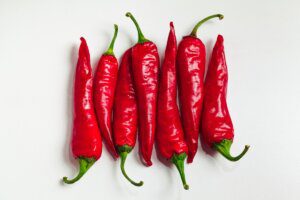
2. Jalapeno pepper: A medium-heat pepper that is thick and somewhat bent. Jalapenos are popular in Mexican cuisine and can be eaten fresh or pickled.

3. Serrano Pepper: Similar to Jalapeos in look, but smaller and spicier. Serrano peppers are frequently seen in salsas and sauces.
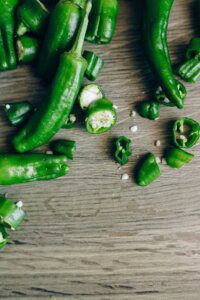
4. Fresno peppers: Fresno peppers, which are similar in size and shape to jalapenos, have a fruitier taste and a somewhat greater heat level.

5. Habanero peppers: Habanero peppers are small, lantern-shaped peppers with a strong, fruity flavour and a high heat level. Habaneros are among the hottest peppers used in a variety of cuisines.
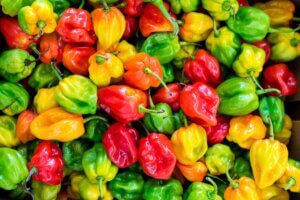
6. Scotch Bonnet pepper: A close relative of the Habanero, Scotch Bonnet peppers are shaped like a bonnet or a little hat and have a comparable heat intensity.
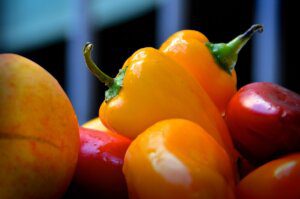
7. Piquillo pepper: A sweet and mildly spiciness pepper from Spain that is frequently used in salads and filled meals.
8. Shishito pepper: Shishito peppers are mild, wrinkled peppers that are often used in Japanese cooking. They are frequently served blistering as a snack or starter.
9. Bell pepper: Also known as sweet pepper, this mild and crisp vegetable is frequently used in salads and cooking. It comes in a variety of colours, including red.
10. Padron pepper: Padron peppers are typically served fried and seasoned with salt. They are small, green when young, turning red when mature, and have a varying heat level.
11. Poblano Pepper: A dark green pepper that becomes red when ripe, it is used frequently in Mexican cuisine like chiles rellenos and is recognized for its mild to medium spice.
12. Red Thai Pepper: These little, hot peppers are frequently used in Thai cooking to give food a strong kick of spice.
13. Habanero Pepper: A common ingredient in Caribbean and Mexican cooking, the habanero pepper is a small, lantern-shaped pepper with a fruity flavor and a strong level of heat.
14. Banana Pepper: Long, tapering peppers with a mild to moderate heat that are known as banana peppers are frequently pickled or used in sandwiches and salads.
15. Tabasco pepper: These little peppers, which bear the name Tabasco after the well-known hot sauce, are quite fiery and are used to manufacture the well-known condiment.
16. Piri pepper: Small, powerful peppers with African roots known as piri piri are used in the renowned Portuguese piri piri sauce.
17. Anaheim pepper: Especially for roasting and stuffing, the mild, elongated Anaheim pepper is frequently used in Mexican and Southwestern cooking.
18. Trinidad Scorpion Pepper: A burning level of spiciness defines the Trinidad scorpion pepper, one of the hottest peppers in the world.
19. Ghost Pepper: The ghost pepper, also known as bhut jolokia, is a common ingredient in Indian food and was formerly thought to be the spicy pepper in the world.
20. Carolina Reaper Pepper: The Carolina Reaper Pepper is now the hottest pepper in the world, therefore it’s not for the faint of heart.
21. Cherry Pepper: Due to their mild taste, cherry peppers are small and rounded and are frequently pickled or used in stuffing.
22. Paprika Pepper: Sweet peppers of the paprika variety are frequently dried and processed into paprika powder, which gives food color and flavor.
Who knows what else the world out there has in store for us! There are many more types of red chillies available out there. Each type has its own unique characteristics.
How to select red chilli peppers
The flavour and spiciness of your foods may be dramatically influenced by the red chilli peppers you use. Here are some guidelines for selecting the best red chilli peppers:
Freshness: Look for peppers that are firm, plump, and fresh. Peppers that are wrinkled, shrivelled, or have mushy patches are past their prime and should be avoided.
Colour: Red peppers should be bright and uniform in colour. Peppers with uneven colour or green areas should be avoided since they may not be fully ripe.
Size and Shape: Select peppers that are uniform in size and shape to guarantee proper cooking and taste consistency.
Consider the degree of heat you want in your meal. Smaller peppers, such as Thai Bird’s Eye Chilli, are often spicier, whilst bigger types, such as Fresno peppers, are gentler.
Smell: Gently smell the peppers. The perfume of fresh red chilli peppers should be intense and hot. Peppers with a musty or unpleasant odour should be avoided.
If you intend to utilize the peppers right away, choose the ones that are ready to eat. Choose slightly underripe peppers to keep for a longer period, since they will mature further over time.
Purchasing Red Peppers: Purchase red chilli peppers from reputed merchants or farmers’ markets to assure quality and freshness.
Handle Peppers Gently: When picking peppers, use care to prevent bruising or harming the delicate skin.
Remember that even within the same type, the heat degree of red chilli peppers can vary. To decrease the spiciness in your recipes, reduce the number of chilli peppers used or remove the seeds and membranes, which contain the majority of the capsaicin, which causes heat. Experiment with many red chilli peppers to find the ones that best fit your taste preferences and desired level of heat.
How to store red chilli pepper
Red chilli peppers must be stored properly to retain their freshness and taste. Here are some incredibly effective suggestions for storing red chilli peppers:
Refrigeration
Refrigerate the chillies if you want to use them within a few days. To keep chillies fresh, it is very essential to ensure good airflow. A good old perforated plastic bag or a vessel with ventilation holes should do the trick. Keep them in a sealed container to prevent the accumulation of moisture and the growth of mould or other creepy fungi.
Freezing
You may freeze red chilli peppers to enhance their shelf life. Wash the peppers after removing any stems. Then, place them on a baking sheet in a single layer and freeze until they are firm. Then, for storage, a freezer-safe bag or container should do the trick for up to six months. Ensure that there is as little air as possible before storing.
Drying
Drying red peppers is another way to preserve them. The peppers need to be hung in a warm, airy, well-circulated area. Other methods include a food dehydrator or a low-temperature oven. The dried peppers should be kept in an airtight container and kept in a cool, dark place.
Pickling
Pickling is a popular way of preserving red chilli peppers. Prepare a vinegar-based brine, soak the peppers in it, and refrigerate for several weeks in sterilized jars.
Refrigerate after cutting
If you have only used a piece of the red chilli peppers, wrap the remainder carefully in plastic wrap or set it in a covered container and refrigerate it. To guarantee freshness, use the leftover peppers within a few days.
Avoid Direct Sunlight
Keep red chilli peppers away from direct sunlight to prevent them from losing their colour and taste.
You may increase the shelf life of red chilli peppers and enjoy their spicy taste in your culinary creations for a prolonged length of time by following these storage suggestions.
Is red pepper chilli or Capsicum?
Both sweet bell peppers (Capsicum) and spicy chilli peppers are referred to as “red pepper” in several locales. Which kind of pepper is being discussed depends on the place and context in which it is utilized. “Red pepper” can refer to both spicy chilli peppers and sweet bell peppers depending on the region. Therefore, depending on the context of the discussion or recipe, any interpretation can be accepted.
What is the benefit of red chilli pepper?
- Increased Metabolis
- Heart Health Support
- Relief from Pain
- Increasing Immunity and Digestion
- Mood improvement
- Respiratory health
- Antibacterial Qualities
What is red capsicum called?
Red capsicum is known as “red bell pepper” or simply “bell pepper” in various locales. What is commonly known as “bell pepper” in the United States and Canada is frequently referred to as “capsicum” in nations like Australia, New Zealand, and India. So the words “red bell pepper” and “red capsicum” both refer to the same vegetable, a sweet and mild pepper that turns bright red when ripe.
Conclusion
In conclusion, red peppers offer a variety of health advantages in addition to adding heat and taste to food. With their outstanding nutritional content, which includes vitamins C and A, potassium, and iron, they help general health by adding variety to the diet. The key ingredient that gives them their spicy flavour, capsaicin, may also increase metabolism, reduce pain, and improve heart health.
Red peppers should be used as often as possible, so pick ones that are fresh and vivid and store them correctly to preserve their flavour and freshness. Whether you like a mild or powerful heat, these peppers can add a delightful edge to a range of meals, from savoury to sweet. However, it’s important to use them cautiously and keep in mind each person’s tolerance level. To boost your health, embrace the fiery attraction of red chilli peppers and let them give your culinary adventures a spicy kick.
Trending: The Incredibly Complete Guide To White Sesame Seeds, +2 Recipes


